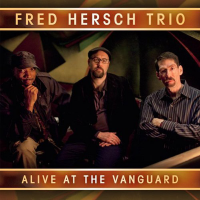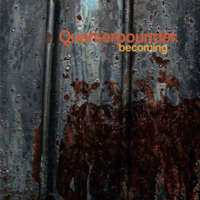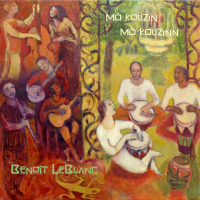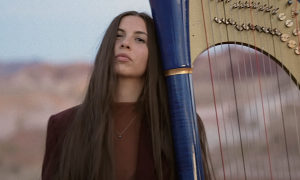Home » Jazz Articles » Interview » Kevin Brandon: Brandino Is In The House
Kevin Brandon: Brandino Is In The House

Picking up the bass at a young age, this self-taught player used music as a means to survive the mean streets of South Central Los Angeles in the early 1960s and '70s. Brandino is serious about life and seriously passionate about his music and art. He doesn't mix words and tells you like it is. Keeping it real in out and of the studio, Brandino has a reputation of laying down a track on the first take.
All About Jazz: I have never seen a bassist—or any musician, for that matter—move his head around as much and as fast as you do when you are playing. How do you do that and not give yourself whiplash? Where did that come from?
Kevin Brandon: I get pretty intense when I play. A lot of emotions and pain need to leave my body in a positive way, so I guess it's pure expression when I do the whiplash thing. Born in South Central and being an in and out patient of Shriner's Hospital for the first five years of my life might have something to do with it.
AAJ: There is an interesting story behind your childhood and how you were able to pick up the bass. Can you share that?
KB: I started playing piano at about age four, with my sister as my teacher. I started to play the saxophone with my brother at seven years of age. Then my brother and sister formed a band and they needed a bassist; I wanted to play drums, but my father didn't want me to get discouraged from the physical hardship on my legs, so they thought it would be better for me to play bass. So my father went to the swap meet to purchase a St. George bass for twenty dollars, and that was my first gig—with my family, playing bass at nine.
AAJ: Your roots are in New Orleans. How did that experience influence your personal and musical direction, and life?
KB: My father and mother had a lot of music that they brought with them when they moved from New Orleans. Jazz, blues, swing, big band, classical, and wide mixture of music like gumbo. So I used to come home from school and pull out 33s, 45s—whatever was in the collection—and decide what songs and recordings I liked and disliked.
AAJ: We are half way through 2012, what has the year been like so far?
KB: A lot TV writing, using my Warwick Single Cut five-string bass over loops and beds. Working on Will I AM s and Justin Timberlake's new CDs. Working with my fusion/funk group, Brandino and Friends, around town. Started on Brandino 's Melodies and Songbook Volume 2 and forming my Bass Quartet group with four acoustic basses.
AAJ: What are you currently working on?
KB: New music and a DVD on my band, writing for the shows Ancient Aliens, Lock Up, Wicked Tuna, Kickin' It, Pit Bulls and Parolees, Code 9, etcetera. Releasing a straight-ahead CD and a solo album.
AAJ: What is in store for you for the rest of the year?
KB: I'm going to Germany in September to hang out with my Warwick Family CEO and founder Hans Peters, [as well as bassists] Jonas Hellborg, Steve Bailey, Larry Graham, Bootsy Collins, Verdine White and all the other endorsers for a 30-year anniversary of the company, which will be a complete party in itself. Bass Player Live, in October in LA, and the seventh Grand (a popular whisky bar in downtown Los Angeles) performance in November with Brandino and Friends.
AAJ: What goes through your mind when you look back at where you started and where you are now?
KB: Well, I'm still here doing what I wanted to do as a kid, which was to play my bass and make music. I think the older you get things get better because you get wiser about life and the decisions you make. And you can reflect on the things you had fun doing up to this point and the things you going to do in the present and future.
AAJ: Who were your earliest musical influences?
KB: The early recordings I stated earlier in the interview. All the recordings that were on the radio in the mid-'60s and '70s, and bass players like Ray Brown, Paul Chambers, Ron Carter, Chuck Rainey, Wilton Felder and James Jamerson, to name a few.
AAJ: How did your musical influences grow and/or change over time?
KB: As I started to play with so many groups stated in my bio, my music vocabulary grew, matured, and developed in each musical experience I was involved in. Growing into an encyclopedia of knowledge from these experiences.
AAJ: What artists and bands do you enjoy listening to today?
KB: I listen to all types of music when I have a break in my schedule.
AAJ: What was your first big break as an professional musician?
KB: The Tommy Dorsey band in New York City, when I was 19.
AAJ: Was there a specific moment or time in your life when you realized that you had a gift and the skill set and competency to play with the best?
KB: I told my mother, at an early age, that I didn't have to go to school because I was going to be a professional musician, I think I was nine.
AAJ: When did you know that you could hold your own?
KB: When I went through the Cerritos College Summer Camp for kids during high school with my friend the great Poncho Sanchez and graduated high school. I was ready to take on the World [laughs].
AAJ: How would you describe your playing style and approach toward your craft?
KB: I play and perform like it's your last gig, so you must make everything count because you never know what life will bring or cut short. I approach playing bass as a sideman, leader, arranger, orchestrator and composer. I like to see how I can make the musical situation better and move into a memorable experience.
AAJ: What was the nicest and most personal compliment that you received as a musician?
KB: If James Jamerson were alive to hear you play, he would definitely be digging on where you are coming from.
AAJ: Do you recall your introduction to the world of jazz?
KB: Louis Armstrong in 1959, when I was released from the hospital. My father treated me to his concert at the Palladium in Hollywood. Besides my early experiences with my family's record collection, when I started learning acoustic bass as my main instrument, the musical journey went deeper into the roots of the music.
AAJ: What are the most challenging projects that you have worked on and why?
KB: Besides doing an audition for Frank Zappa—I wasn't interested in the gig, but wanted to check out the music—probably performing with my pal Billy Childs, going to Hong Kong with a black ballet company from Los Angeles.
AAJ: What were the most rewarding projects that you worked on and why?
KB: Working with the Queen and King of Soul—Aretha Franklin and James Brown—is something that a person never can forget as a soul experience.
AAJ: Which albums are you most proud of and why?
KB: All the albums I've worked on are special because of the musical experiences. But working on the Outkast CD in 2004 was where I was introduces into the commercial Grammy world of recordings—and all the others that came after that, with my friend Benjamin Wright, gave me commercial recognition.
AAJ: How many Grammys do you have?
KB: Seven.
AAJ: The desert island question....If you were stranded on a desert island and could only bring 10 albums, which albums would you bring?
KB: I can't answer that because I would have to bring my 20 apple crates of LPs with me.
AAJ: What gives you the most joy out of playing?
KB: Making people feel good and enjoy the music.
AAJ: BTW, what is the brand and model of your bass?
KB: Warwick out of Germany Single Cut
AAJ: Is there a story behind how you chose your bass over others?
KB: When Warwick was looking for US endorsers to play there line of instruments Jimmy Earl told Hans Peters about John B Williams, on the Arsenio Hall Show, and myself, working with Aretha, going to do Bill Clinton's White House Inauguration Celebration. I loved the instrument the first time I played it because it was built like a high quality acoustic bass; Germany has a reputation going back many centuries in history as makers of fine string instruments.
AAJ: Is there anyone out there that you would like to work with but have not had a chance?
KB: John Coltrane and Miles Davis [laughs].
AAJ: Can you describe your typical approach to composing and creating new music?
KB: Looking at a video clip or film usually brings out a story from the scene and a musical idea usually comes into mind. Writing songs usually start with a groove of some sort; then ,you stack some ideas on top of that, like your making gumbo, until all the ingredients or ideas work.
AAJ: When you are playing live, and find yourself in a "creative zone or groove," are you thinking about the notes and changes or are things just flowing naturally?
KB: I'm usually in a zone from the music and letting spirit guide me along the musical path; it's more pure and real.
AAJ: To date, which artists and contacts in the industry have been the most helpful to you and have guided you in the right direction?
KB: I would say my friends Benjamin Wright, HB Barnum, and Ernie Fields, who have enjoy working with me and given me opportunities to let me do me on the bass.
AAJ: What are you favorite venues to play? KB: At this point in time it's the 7th Grand Whiskey Bar in downtown LA.
AAJ: If you could assemble the Brandino Dream Team Jam from any musician past or present, what musicians would be playing with you on stage?
KB: Elvin Jones on drums, Coltrane on sax, Miles Davis on trumpet and Herbie Hancock on piano.
AAJ: What songs would be on your dream set list? Remember, this is a dream list so it can be long.
KB: My song, " Where is the World Going," would be the song I would like to perform with these greats; after that it would have been all said.
AAJ: As you progress as an artist and a composer, does the creative process associated with writing new music become easier or harder?
KB: It's a little bit of both. Sometimes things come spiritually inspired and it goes the way it's supposed to; then there are times that you are looking for that right phrase and it might come in a day, week, or month. You never know about the creative process.
AAJ: How important have the internet and social media been to you as an artist?
KB: It's something everybody needs to deal with and, if you use it to your advantage, it can help you reach out globally in ways you could never do in the past. In 1987, I started going back to school, dealing with computer classes in media to stay on top of where technology was heading and how I could use it to my advantage as an artist and in my business.
AAJ: How difficult and time consuming is it to stay on top of your social media responsibilities?
KB: It's real hard and time consuming. You really need to allocate your time wisely and focus on what you are trying to write, record, or market in the entertainment world.
AAJ: How much time do you spend practicing?
KB: About two hours a day
AAJ: How much time did you use to spend practicing?
KB: About eight to ten hours a day.
AAJ: Who are your jazz heroes?
KB: Louis Armstrong.
AAJ: Who are your rock heroes?
KB: Jack Bruce.
AAJ: Who are your bass heroes?
KB: Slam Stewart.
AAJ: How would you describe your musical style?
KB: Different.
AAJ: What do you do for fun?
KB: Work on my 1965 Ford Econoline van.
AAJ: What is your favorite restaurant?
KB: RJ Southern Home Cooking Restaurant in Downey, CA.
AAJ: How did your family influence your development as an artist?
KB: They introduced me to a lot of different kinds of music.
AAJ: How important is chemistry with fellow band members when you are on tour?
KB: Without chemistry in your band, you don't have a band, you have individuals playing what they want to play individually, instead of collectively.
AAJ: What was your formal musical training like?
KB: Classical flute lessons in high school from Milton Hall, Watts, CA; harmony by Walter Piston; techniques of 20th Century composition by Leon Dalin; 20th Century harmony by Vincent Persichetti; counterpoint by Kent Kennan, and more.
AAJ: Did reading music come easy to you?
KB: It was hard at first but when you enjoy playing an instrument, you want to perform as much music on that instrument as you can, to open up possibilities performance-wise.
AAJ: Are there any musicians in your family?
KB: My sister played piano and my brother played saxophone and piano. My parents did not play.
AAJ: How supportive was your family with respect to your early adventures in music?
KB: Really supportive, music gave me a chance, It kept me out of trouble so that was good, but it also gave me a chance to excel where I knew I could.
AAJ: How has jazz influenced your life and music?
KB: Jazz is part of my DNA.
AAJ: Who were your early jazz influences?
KB: All the greats!
AAJ: Who are your current jazz influences and likes?
KB: I really don't have though influences anymore. They do what they do and I do what I do.
AAJ: How would you describe yourself as a person?
KB: Very positive and energetic.
AAJ: How would you describe yourself as a musician?
KB: I really don't judge myself; you tell me, you heard me play.
AAJ: What do you do for fun?
KB: Work.
AAJ: How do you relax?
KB: Chamomile tea.
AAJ: What was your most embarrassing experience on stage?
KB: Breaking a high G string in the middle of the show Dream Girls, where there are no stops in the music.
AAJ: What were some of you special on stage moments and memories?
KB: The time Aretha performed at Navy Pier in Chicago and the band kept playing for about 20 minutes after she had already left the stage. The band was so much in a groove and trance; we didn't know she had actually left the stage.
AAJ: Describe a typical day in your life when you are on tour?
KB: Get up, get some breakfast in the hotel café, wait for the band to collectively unite and get to the next city to perform and start it all over again the next day.
AAJ: Describe a typical day in your life when you are home.
KB: Coffee in the morning, feed the dogs, turn on the computer, check email, practice, run errands. Come back and start writing, go to the studio to record on an album. Make sure If I have any writing assignments for the week, if not go have some fun.
AAJ: How do you balance your home life and your professional life?
KB: It's a challenge some time, but if you focus on the duties you have in front of you and plan your time. You can be amazed how much you can accomplish.
AAJ: What is the most difficult aspect of your work?
KB: Meeting two or three deadlines at the same time.
AAJ: When you are playing live are there any significant differences between jazz, rock, fusion, or blues sets?
KB: It's all music to me.
AAJ: I noticed an old Ford pickup truck in your yard. What is the story behind that?
KB: That's one of my hobbies to complete.
AAJ: I know that a big part of you is interested and involved in giving back to the community and, in particular, helping young kids find their way in life. Can you tell us more about this aspect of your life?
KB: I spend a lot of my time working with a special foundation that helps physically and mentally challenged kids and the under privileged in the inner city. We help them to become functionally self sufficient in society. I spend a lot of time trying to find support for the program and ways to expand what we are doing to other cities. We are online at www.youcandoitifyoutry.org
AAJ: I also noticed a stack of computers in your garage. What is the story behind that?
KB: The computers were donated to the program but we cannot do much with them until we have a secure building to use them in. It is frustrating having them here and not being able to put them to use.
Selected Discography
Brandino, Midnight Fantasy (N' House Records, 2010)
Brandino, Live (N' House Records, 2010)
Robbie Krieger, Singularity (Oglio, 2010)
Brandino and Friends,Live at Charlie O's Volume 1 (N' House Records, 2008)
The Temptations, Back to Front (New Door, 2007)
Joss Stone, Introducing Joss Stone (Virgin, 2007)
Justin Timberlake, FutureSex/LoveSounds (Jive, 2006)
Stevie Wonder, Conversation Piece (Motown, 1995)
Stanley Turrentine, LA Place (Blue Note, 1989)
Photo Credit: Scott Mitchell
Tags
Kevin Brandon
Interview
Scott Mitchell
United States
California
Los Angeles
Tommy Dorsey
Stevie Wonder
Aretha Franklin
Jonas Hellborg
Steve Bailey
Bootsy Collins
Verdine White
Ray Brown
Paul Chambers
Ron Carter
Chuck Rainey
Wilton Felder
James Jamerson
Louis Armstrong
Frank Zappa
Billy Childs
James Brown
John Coltrane
Miles Davis
Elvin Jones
Herbie Hancock
Jack Bruce
Slam Stewart
PREVIOUS / NEXT
Support All About Jazz
 All About Jazz has been a pillar of jazz since 1995, championing it as an art form and, more importantly, supporting the musicians who make it. Our enduring commitment has made "AAJ" one of the most culturally important websites of its kind, read by hundreds of thousands of fans, musicians and industry figures every month.
All About Jazz has been a pillar of jazz since 1995, championing it as an art form and, more importantly, supporting the musicians who make it. Our enduring commitment has made "AAJ" one of the most culturally important websites of its kind, read by hundreds of thousands of fans, musicians and industry figures every month.




























